EVGA GeForce GTX 680 Classified Review: Pushing GTX 680 To Its Peak
by Ryan Smith on July 20, 2012 12:00 PM ESTPower, Temperature, & Noise
Wrapping up our look at the stock performance characteristics of the GTX 680 Classified, we have what’s perhaps our most important results section: power, temperature, & noise.
When it comes to custom cards these results can often make or break a card, depending on the niche it’s going for. The GTX 680 Classified is a high performing card, but it’s not a card shooting for performance at any cost, so we expect to find some kind of reasonable balance here.
| GeForce GTX 600 Series Voltages | ||||
| EVGA GTX 680C Boost Load | Ref GTX 680 Boost Load | EVGA GTX 680C Idle | ||
| 1.175v | 1.175v | 0.987v | ||
Note that at its stock settings EVGA must follow NVIDIA’s defaults, so the GTX 680 Classified has the same 1.175v load voltage as the reference GTX 680. This is where binning comes into play, as EVGA needs to identify GK104 GPUs that can reach 1100MHz+ at 1.175v in order to make the GTX 680 Classified a viable product.
| EVGA GTX 680 Classified Average Clockspeed | |||
| Game | Clockspeed | ||
| Crysis: Warhead | 1188MHz | ||
| Metro 2033 | 1211MHz | ||
| DiRT 3 | 1211MHz | ||
| Shogun2 | 1162MHz | ||
| Batman: Arkham City | 1188MHz | ||
| Portal 2 | 1211MHz | ||
| Battlefield 3 | 1188MHz | ||
| Starcraft II | 1188MHz | ||
| Skyrim | 1211MHz | ||
| Civilization V | 1188MHz | ||
Meanwhile, looking at the GTX 680 Classified’s median clockspeed during our benchmarks, we can see that our earlier speculation about the impact of such a high power target was true. The maximum boost bin on our card is 1201MHz (versus 1110MHz for our reference card), and with the exception of Shogun 2, the GTX 680 Classified is almost constantly at 1201MHz or the temperature-induced 1188MHz during our tests. With Shogun 2 that drops down to 1162MHz. With such a high power target the resulting clockspeeds are very consistent for a GTX 680 card.
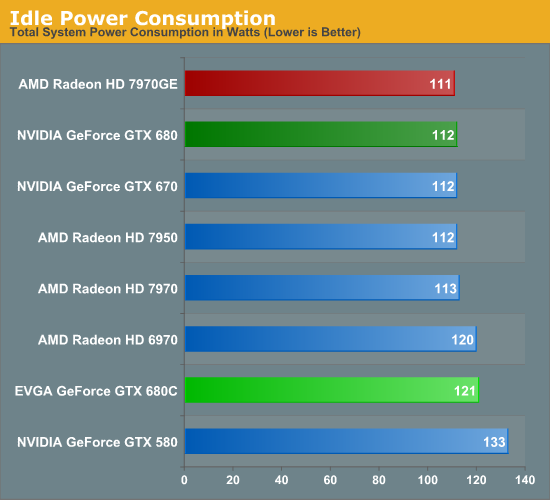
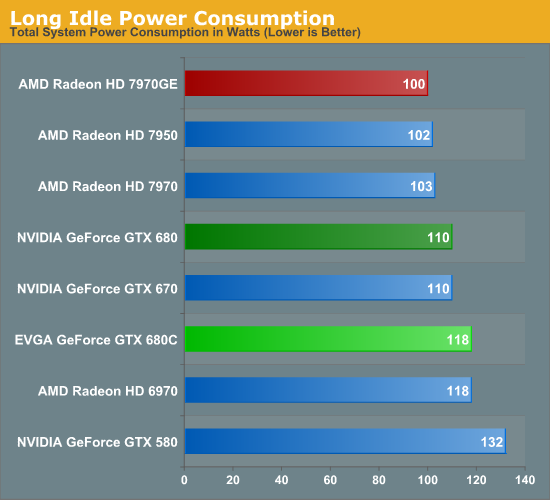
Moving on to power consumption, there are no great surprises here for the GTX 680 Classified when it comes to idle power consumption. With the additional VRM phases and more importantly 8 extra GDDR5 memory chips, idle power consumption has to go up. The impact is that idle power consumption rises by 8-9W, which would push the total idle power consumption of the card up to around 25W. Note however that this is still better than the GTX 580.
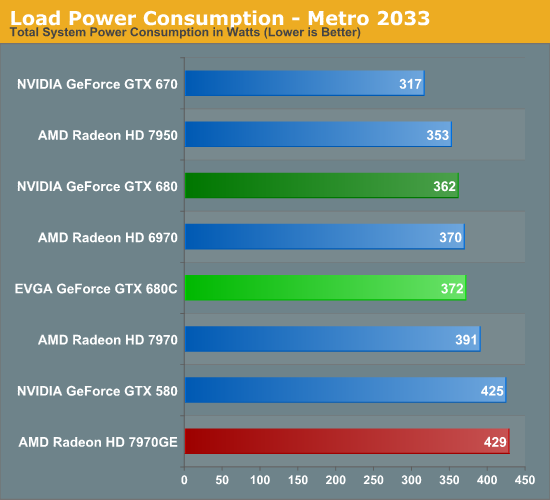
Load power on the other hand looks very good. In fact it’s much better than we were expecting. Despite the additional memory chips and the factory overclock, under Metro power consumption only rises 10W at the wall. This is still less than the7970, let alone the 7970GE.
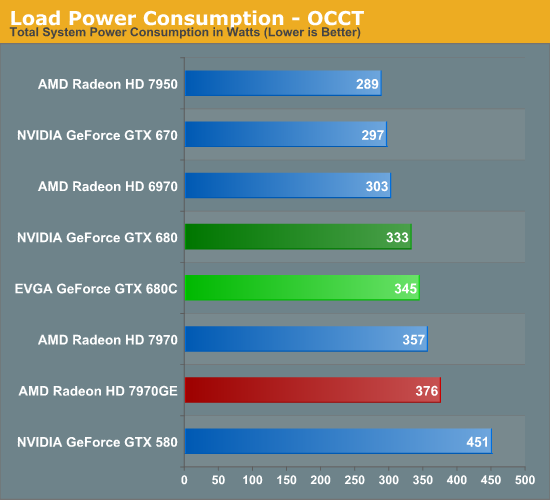
The story with OCCT is much the same. Here we can see that power at the wall increases by all of 12W, which is roughly the remaining difference between the GTX 680 Classified and the 7970. Ultimately the binning process necessary for EVGA to assign GK104 GPUs to their various products has pushed the very best GK104 GPUs into the Classified. The end result is that even at NVIDIA’s standard voltage of 1.175v, the GK104 GPU in our card ends up consuming less power than a more typical GK104 GPU, which allows the GTX 680 Classified to partially offset the higher power consumption of the additional RAM, additional VRM phases, and the factory overclock.
The final result is that the GTX 680 Classified still consumes a bit more power than the reference GTX 680, but not immensely so. Furthermore depending on whether we’re looking at Metro or OCCT, the GTX 680 Classified still draws 30-50W less than the next-nearest competitor, the 7970GE.
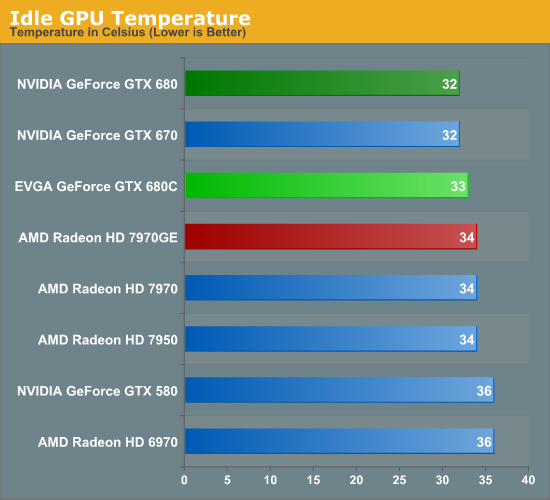
Moving on to temperatures, since EVGA has equipped the GTX 680 Classified with what’s functionally a larger version of the GTX 680’s blower, there are no grand surprises here. The GTX 680 Classified idles at 33C, which so far appears to be typical for these latest iterations of high-performance video cards.
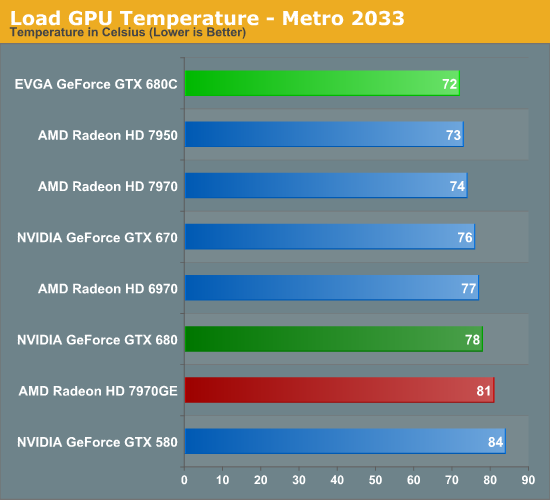
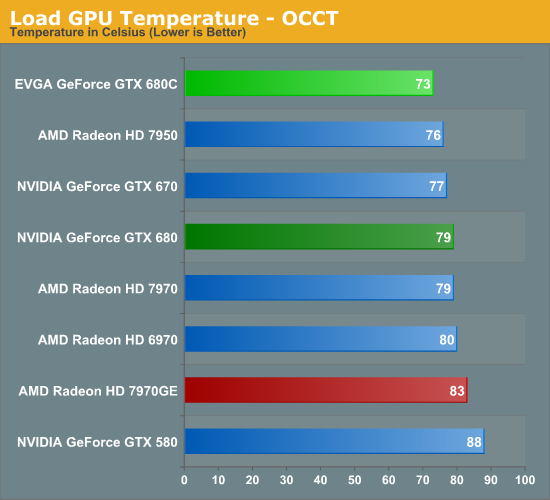
Load GPU temperatures on the other hand are clearly benefitting not only from the larger cooler of the GTX 680 Classified, but also its lower GPU power consumption. With both OCCT and Metro the GTX 680 Classified is 6C cooler than the reference GTX 680. Blowers aren’t known as the most effective coolers, so to reach the low 70s like this is definitely impressive.

Last but not least we have our look at noise levels. Starting with idle noise, the GTX 680 Classified makes no significant tradeoff for its size. Idle noise ends up being a hair higher than the reference GTX 680, but not noticeably so.
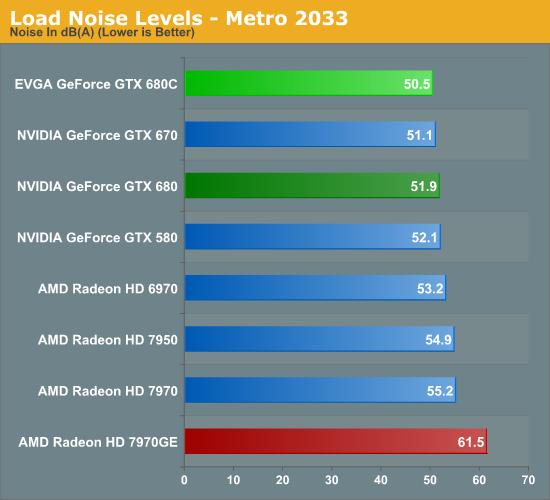
With load noise levels on the other hand we find ourselves once again impressed. The larger cooler and larger fan means that the GTX 680 Classified generates less noise than even the reference GTX 680, which was already a fairly quiet card for its performance level. We had expected EVGA to make some kind of temperature/noise tradeoff here but there’s none to be found. They have managed to lower both at the same time.
Ultimately it’s clear that while EVGA has engineered the GTX 680 Classified for heavy overclocking, they haven’t sacrificed reference performance to get there. When it comes to both temperatures and noise, the GTX 680 Classified is suitably superior to the reference GTX 680. The fact that EVGA did all of this with a blower makes it all the more impressive, since we typically only see gains like these by switching to an open air cooler. Granted these improvements are largely a consequence of the need to overbuild the card for the kind of heavy overclocking it was designed for, but if you do run at stock there are definitely benefits to be realized.










75 Comments
View All Comments
Grooveriding - Friday, July 20, 2012 - link
Very disappointing card for that price. $660 for this ?The MSI GTX 680 Lightning can also be overclocked and overvolted, showed higher overclocks, has a better cooler and costs less than this card.
More disappointment from EVGA along with their scaled back warranty and the need to pay them additional money for extended warranty coverage/stepup program.
/thumbs down
RussianSensation - Friday, July 20, 2012 - link
$740 for the EVBot controller + a card with a blower fan, dinky heatsink (compared to MSI Lightning 7970/680 and Sapphire TOXIC 7970) is overpriced imo. It's not like the extra 100mhz or 4GB of VRAM over 2GB 1230-1290mhz GTX680s will make this card more future proof for next generation games.To make it even more laughable, this card isn't even close to the fastest factory preoverclocked GTX680 either:
http://www.newegg.com/Product/Product.aspx?Item=N8...
If I wanted the best single-GPU with bragging rights, I'd rather get the GTX690 at that point. The 690 would be much faster and quieter and actually be good to go for next gen games. This seems like a marketing exercise.
Ryan Smith - Friday, July 20, 2012 - link
The thing is that I really don't consider a blower to be a negative thing here. This card barely passed 50dB under load, and at the same time it's fully exhausting. Open air coolers have their place, but not having to worry about additional case cooling is quite convenient.RussianSensation - Saturday, July 21, 2012 - link
Ya, I agree that this blower is one of the better ones. But even from your review, the blower was struggling to keep this card under 70*C with overvolting. Under regular overclocking, it worked perfectly fine but the card only reached 1211MHz (1301 with GPU Boost). Those clocks are nothing special and plenty of $500-560 GTX580s such as Gigabyte Windforce 3x, Asus Direct CUII, Zotac AMP!, Galaxy KFA2 can reach those clocks. So the question is why is this card $660? 4GB of VRAM is a waste at 1080/1200P and at 2560x1600 with AA, 1.2ghz HD7970 is faster.But if you are going to overvolt, the cooler suddenly becomes a limitation, especially after buying EVBot for $740. Suddenly you aren't too far off from a real special card - GTX690 - that's actually going to be fast enough to play today's and next generation games. Going from 1301mhz to 1377mhz with volt mod is not going to make GTX680 any better for newer games since that's not good enough, especially after you consider that because it gets too hot, the delta is less than 76mhz in actual gaming.
Sabresiberian - Sunday, July 22, 2012 - link
The overvolted card reached 83C in the review - but the max recommended temp for a GTX 680 is 98C. It did that keeping the noise down to 56.3dB.I tell you what I think - the people that have problems with EVGA's choice of cooling here is simply that it's not sexy. The fact that it works well is secondary.
The overclocked Classified is faster than the 7970GE in 4/5 games @ 2560x1600 in this review. It's faster in 5/9 of them.
Spunjji - Monday, July 23, 2012 - link
I don't think you can call 56.3dB "keeping the noise down", though. That's approaching conversational levels of noise - more importantly the fans on blower heat-sinks sound subjectively worse; less like the broadband noise of a desk fan and more like the drone of a hair-dryer.So, it's not all about "style". There are other legitimate concerns at play here.
CeriseCogburn - Sunday, July 29, 2012 - link
" Supplying this power is a pair of 8pin PCIe power sockets, which means on paper the GTX 680 Classified can safely draw up to 375W. In practice it’s not clear whether GK104 can actually take that, at least with air cooling, so pushing this card much beyond 300W is mostly in the realm of hardcore water and liquid nitrogen overclockers. "blag blah blah blah: is overpriced imo. It's not like the extra 100mhz or 4GB of VRAM
blah blah blah blah: To make it even more laughable
blah blah blah blah: Those clocks are nothing special
blah blah blah blah: This seems like a marketing exercise
You seem like a moron.
RussianSensation - Sunday, September 2, 2012 - link
We were discussing this card's value vs. the GTX680 Lightning. It's worse than the Lightning in overclocking, price and noise levels. Compared to the 7970, it's ridiculously overpriced and will get beaten by a 1250mhz 7970. So there are at least 2 better options on the market: GTX680 Lightning and Sapphire Vapor-X 7970 GE. Plus, at these prices, you can now get HD7950 Crossfire or catch a sale on 2 GTX670s for $340 each. Sorry but $660 for the Classified is a rip-off.As of September 2, this overpriced pile of garbage is still $660 on Newegg, and then you need to add $60+ for EVBot = $720:
http://www.newegg.com/Product/Product.aspx?Item=N8...
That's a joke and a half. Almost $300 more than the Vapor-X, $180 more than the GTX680 Lightning, and still more expensive than the fastest single GPU this round: Sapphire TOXIC 7970.
Plus, this Classified pile of overpriced marketing will get owned by $640 MSI TwinFrozr III 7950s in CF or $730 GTX670 SLI.
Seriously, only non-nonsensical fanboish noise comes out of your mouth. Even among NV's choices, this card is terrible.
Sabresiberian - Sunday, July 22, 2012 - link
Nice link to a deactivated product in which 4/9 of the people that bought it had trouble. I wonder why it was deactivated? Speaks to the quality of your entire post. "Dinky heatsink". Did you read any of the article at all?Yeah, I'm going to be spending all my video card money on Galaxy products, for sure. I especially like that their card had one DisplayPort and 3 HDMI ports. I'm sure I'm going to run 3 TVs off it.
ubernator44 - Monday, September 17, 2012 - link
alright so you must realize that:1; you will never see the potential out of this card with only air or normal liquid cooling.
2; because of #1 anyone who isnt into phase change/ln2/ or sub zero cooling thinks this is a waste.
you must realize that this thing has 18 power phases O.o like holy crap. the only real perk this card has is its amazing ability to reach extreme clocks at low voltages given the fact you use subzero cooling. anything else is just not adiquate. so yes, for 90% of people, this thing is a 660 dollar brick, for us extreme overclockers, this is a godsend! just look at kingpin and what he got off this beast. for you gamers out there that only use a max of normal liquid cooling, a 680 FTW+ is probly all you will want to pay for. anything else (like this card) is useless to you. so yes, amazing card, small market target, but they made it anyway, which is rare for a company to do!